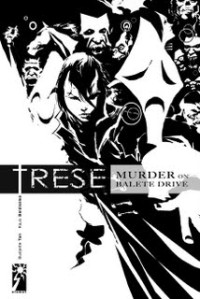Armanaz, Armazan… He’s still a tikbalang living in a penthouse suite.
Where life and light should be are only shadows and grey lines. The map of Trese’s Metro Manila contains no details. All I know is that I am in there somewhere, living my ordinary life, and they are there as well, loving and hating, the same us us, side by side with us, however hard we pretend they are not there. And sometimes, out of passion or greed, they commit crimes.
 Who do I call for paranormal help then?
Who do I call for paranormal help then?
With a concept as striking as this, who would fail to pick up this latest work of genius from a dynamic Filipino duo, Budjette Tan and Kajo Baldisimo? Especially now that the country’s publishing industry is struggling mightily to stay afloat, I can only be overjoyed to encounter innovative concepts take form.
A graphic novel, Trese follows the cases of paranormal investigator Alexandra Trese as she takes on the mantle of psychic dad. The first case is a double-dead mystery, a hit-and-run of a white lady, ghost of a wronged woman who appears to motorists, causing them to swerve and crash. Trese investigates how a ghost could die again, and who would wish to murder her.
In this volume, the first, four cases are featured, dark tales full of tears and violence, drawing heavily on Filipino folklore. The nuno (a little old man) does not live in the punso (ant hill) anymore; it has made another home in a manhole, peering out from under the heavy metal cover to dispense tips for Trese. Aswangs (humans who transform into animals to eat the flesh of babies) hole up at the pier, planning their next kidnapping spree. In the tallest building in the metropolis is the headquarters of the city’s most powerful business tycoon, a tikbalang (a giant, with the face and hooves of a horse) who controls his empire through human underlings. Trese is assisted by the Kambal (twins), creatures of indeterminate paranormal origins, who wear the two masks of man—happy and sad—while in combat. And, engkantos, sentient spirits of nature, are everywhere, assuming human forms to play with humanity’s weaknesses, challenge our strengths, and offer us our dreams—for a price.
With no colors to soften the violence of the drama that plays out in Manila’s underbelly, reading Trese is a visceral experience. The lines are starkly drawn, and there are no clear boundaries between frames. For good or ill, the denizens of the dark live among us, having as much right to be here as we do—and they play no favorites… Case 4 is a case in point.
………………..
Trese is written in English, with only a few Tagalog terms for uniquely Filipino phenomena or mythological beings. I imagine a non-Filipino reader would find it very interesting, yet startling.









Peter
October 18, 2009
Hi, Mitch! Nice review. I’ll check this out soon, since I was just thinking of the perfect book to take to the cemetery on October 31. I think this book is the one!
By the way, have you read Mythology Class? I love that graphic novel!
LikeLike
artseblis
October 18, 2009
oh, not yet. is it by a Filipino also? Trese Unreported Murders is better to take to the cemetery; one of the stories took place in the cemetery by Kalayaan St… =P Trese Mass Murders (vol 3) came out today, said Ishay on FFP.
LikeLike
Peter
October 18, 2009
Oh, yes, it’s by a Filipino author. It’s by Gerry Alanguilan (I hope I got the spelling right). I think you’re gonna love it!
LikeLike
waistline32
March 22, 2010
Nope. It’s by Budjette Tan and Kadjo Baldisimo.
LikeLike
artseblis
October 18, 2009
i’ll check it out then! sabi mo eh!
LikeLike
Johanna
October 19, 2009
Hi! I haven’t tried reading a book by a local author. However, your review makes this particular book quite interesting. I’m glad it is in English, though, as I really have a difficult time reading in Filipino. Will give this book a try—-into my wishlist it goes. 🙂
LikeLike
artseblis
October 20, 2009
hi, johanna! trese is very easy reading, but it somehow pulls you into a murkier city than we normally view it. anyway, i hope you enjoy reading it. thanks for posting!
LikeLike
waistline32
March 24, 2010
Newsflash: Manila is murkier in real life than in Trese.
LikeLike
artseblis
April 6, 2010
hi, waistline. very likely. manila is also more interesting than any book can make it to be. which is why i love living here.
LikeLike
waistline32
March 24, 2010
try reading Nick Joaquin. Best (IMHO) Filipino literature written in English.
LikeLike
artseblis
April 6, 2010
hi, thanks for the recommendation. i also love nick joaquin. i love the passion in his stories.
LikeLike
sumthinblue
October 26, 2009
just finished the two books! hope I can review them in time for halloween
LikeLike
artseblis
October 27, 2009
yey! but relax. we don’t want you becoming sick from exhaustion again.
LikeLike